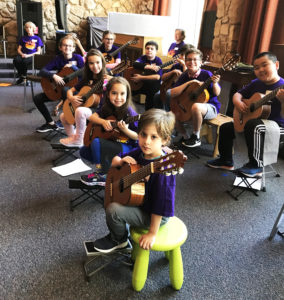The Suzuki triangle consists of three essential parts: the student, teacher, and parent. The parent takes on many roles, including at-home teacher, practice partner, and supporter. As the child gets older, the role of the parent also changes as the student becomes a more independent learner. As teachers and parents, we strive to teach the student how to think and learn independently both as a musician and a person. This journey of learning together provides a unique shared experience between the student, teacher, and parent.
In the early years of instruction, the parent’s main role is as at-home teacher. For this reason, it is important for the teacher to give detailed instructions to the parent for the at home practice sessions and for the parent to take detailed notes in lessons. These “instructions” (notes) are crucial for at home success. Technology, such as digital and video recorders can aid in this at home practice, but should not take place of the careful note taking. As students approach the teenage years, often they want to take ownership of their practice. As teachers, we encourage parents to allow the student to practice alone, for part of their practice session. This can include review pieces or a note reading or theory assignment. As with many aspects of lessons, when to begin this approach depends on the individual and should be discussed between parent and teacher.
In his book, Expanding Horizons, Suzuki violin teacher and teacher trainer Mark Bjork, encourages parents to involve students in the decision making process from an early stage by offering choices such as, “Would you like to practice now or after dinner?” “Would you like to play Lightly Row first or Go Tell Aunt Rhody?” “Do you think you should repeat that section 15 times or would 20 times be better?” These types of questions involve the student in the learning process by involving them in the decision making process. As the student matures, Bjork encourages parents to ask more analytical type questions, which increase the student’s active participation in making decisions. Examples of these types of questions include, after the student finishes a piece ask, “How do you think you played?” After the student responds, the parent asks “What do you think could improve?” and finally “What did your teacher suggest to take care of that problem?” or “How can you fix that?” Offering choices of how to address a difficult area give the student a sense of ownership of his or her playing as well as teaching problem solving skills.
Bjork recommends using a five step practice process with steps that the student can easily identify and learn to use independently:
- Play a piece and ask if anything needs to be improved. (The Examination)
- After identifying the problem, decide how to correct it. (The Diagnosis)
- Do the necessary work to affect a “cure.” (The Medicine)
- Play the piece again to see if the cure has been achieved. (The Check-Up Exam)
- Decide if the cure needs to be continued at the next practice in order to maintain excellent health. (The Maintenance Plan)
While in the beginning stages, the parent will help the student work through this process together, as the student gains independence, healthy practice habits will be in place and the student will have the practice tools needed to achieve their musical goals. Even as the student gains musical independence, the parent’s role continues to support and encourage the student.
Additional Resources for Teachers and Parents: Expanding Horizons by Mark Bjork (2008), Nurtured by Love (1983) by Shinichi Suzuki, Time to Practice: A Companion for Parents by Carrie Reuning-Hummell.

